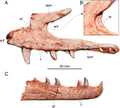Gnathovorax
| Gnathovorax | |
|---|---|

| |
| Photograph, 3D scans, and illustration of the skull of the specimen | |

| |
| Restoration | |
| Scientific classification | |
| Domain: | Eukaryota |
| Kingdom: | Animalia |
| Phylum: | Chordata |
| Clade: | Dinosauria (?) |
| Clade: | Saurischia (?) |
| Family: | †Herrerasauridae |
| Genus: | †Gnathovorax Pacheco et al., 2019 |
| Type species | |
| †Gnathovorax cabreirai Pacheco et al., 2019
| |
Gnathovorax is a genus of
The type specimen comprises a mostly complete and well-preserved articulated skeleton (considered one of the best herrerasaurid skeletons ever discovered), which fossilized in close association with rhynchosaur and cynodont remains. The discovery of this superb specimen has shed light onto poorly understood aspects of herrerasaurid anatomy such as endocranial soft tissues.[1]
Discovery

The holotype specimen, CAPPA/UFSM 0009, is an almost complete and partially articulated skeleton, lacking only portions of the left shoulder girdle and left forelimb. It was found in 2014 at the Marchezan site, in the municipality of São João do Polêsine, Rio Grande do Sul, Brazil. This locality preserved rocks from Santa Maria Formation in the Candelária Sequence of the Paraná Basin. The skeleton was fossilized within a mudstone layer, along with small articulated skeletons of prozostrodont cynodonts. This mudstone layer was then covered by a layer of sandstone containing disarticulated rhynchosaur remains. These fossil remains are indicative of a diverse community of animals at Marchezan. Stratigraphically correlated beds from a nearby site were dated as the middle of the Carnian stage of the Late Triassic, circa 233.23 ± 0.73 million years ago.[1]
The
Description
Skull

There were three teeth in the
The
Postcrania

The neck is short, with keels along the lower edge of its vertebrae (like other herrerasaurids) and long transverse processes (like Sanjuansaurus specifically). The dorsal vertebrae are similar to those of other herrerasaurids, though the tips of the neural spines are only slightly expanded. As with herrerasaurids and most non-dinosaur reptiles, only two vertebrae form the
Gnathovorax is the only herrerasaurid combining features of the scapula such as posterior curvature, an expanded tip, and no fusion with the coracoid. The rest of the forearm is similar to that of Herrerasaurus, with a strongly developed elbow area and a long hand. The ilium is short, although it has a pointed front tip in contrast with the rounded front edge of other herrerasaurids. Gnathovorax is the only herrerasaurid in which the pubis is both sinuous in front view, and projects straight down in side view. The pubis also possesses a large pubic boot with a smooth lower edge, similar to other herrerasaurids, although it lacks the beveled pubic boot of Staurikosaurus. Unlike other herrerasaurids (but like lagerpetids), the ischium has a hole known as an obturator foramen at its base. The femoral head is more simple than that of other herrerasaurids, with a small craniomedial tuber (front inner bump) and no caudomedial tuber (rear inner bump). Otherwise the femur possesses all the muscle attachment sites typical of basal dinosaurs. The tibia is 90% the length of the femur, unlike Staurikosaurus which has a longer tibia. The rest of the lower leg is similar to Herrerasaurus, but the foot has three phalanges (toe bone) in the fifth toe, while Herrerasaurus only has one.[1]
In 2022, Aureliano and colleagues performed a mirco-computed tomography scan on the postcranial skeletons of some of the earliest saurischian dinosaurs that lived during the late
Classification
Gnathovorax was a member of the
Dinosauria
|
| ||||||
Paleobiology

The holotype skeleton of Gnathovorax is so well preserved that its describers were able to reconstruct a digital
Gallery
-
Maxilla and dentary
-
Neck and tail vertebrae
-
Shoulder girdle and forelimbs
References
- ^ PMID 31720108.
- PMID 36494410.
- ^ "Stunning Skeleton Reveals Early Carnivorous Dinosaur".





